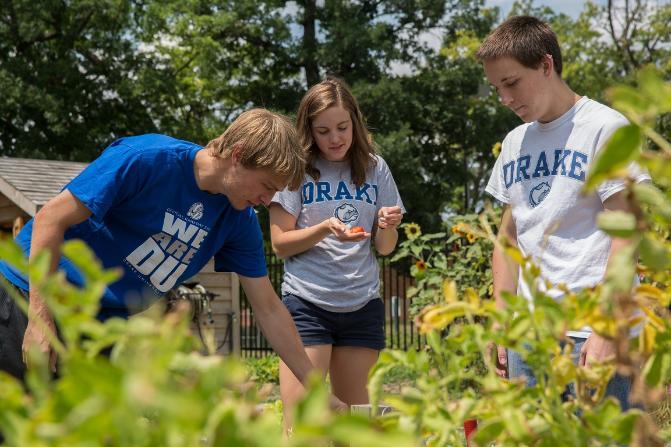Facilities
The Department of Environmental Science and Sustainability has access to numerous facilities and field sites for use both in teaching as well as faculty and undergraduate research.
All of these are intended for undergraduate use, allowing students to gain firsthand experience in modern field techniques and technologies used in environmental assessment, protection, and research.
Biodiversity Center & Greenhouse
The Biodiversity Center at Drake University houses both a herbarium collection and a vertebrate collection including over 3,000 specimens of snakes, turtles and other herps, several hundred mammal study skins, and over 600 bird specimens, mainly representing the regional biodiversity of the Upper Midwest. The avian collections are rapidly growing, and students at Drake have the opportunity to become involved in learning preparation and care of the collections through enrollment in BIO 064: Museum Curation, as well as independent study. The collection includes a large workspace for students, complete with computer stations for data analysis.
Environmental Learning Center
In conjunction with local partners (Southeast Polk School District and Metro Waste Authority) Drake’s Department Environmental Science and Sustainability uses the Environmental Learning Center (ELC) in Runnells as a teaching and research field station. With access to approximately 1,000 acres, the ELC provides our students an opportunity to engage in long-term ecological research, habitat restoration, and teaching. Camp Creek flows through the property, which includes a variety of prairie, wetland, and woodland habitats. ENSS offers courses at the ELC during the J-term, hosts summer camps for both children and educators during the summer, and uses the facilities for labs and research throughout the year.
Chichaqua Bottoms Greenbelt
Drake has partnerships with multiple conservation organizations in the area, but one of the most robust is our work with the Polk County Conservation Board in the Chichaqua Bottoms Greenbelt, an 8,000 acre park on the Skunk River. Our students have worked in the area for over a decade, developing conservation plans, restoring habitat, and doing species surveys for numerous common and endangered organisms. While much of the park is protected, several sites are being used in a long-term cattle grazing study to determine whether there are levels of use where the presence of large ruminants might actually be restorative to an ecosystem historically grazed by bison and elk. As habitat has improved in Chichaqua, otters have proliferated, as have rare species of orchids and other unique organisms, many of which have been caught remotely by Drake trail cameras.
Sprout Garden
The Sprout Garden is the product of a $45,000 grant application written by ENSS students in 2012. Sprout is operated by Drake in partnership with the Boys and Girls Club of Central Iowa (BGCCI), and is the site of service learning and workshops not only for Drake students but also urban youth and immigrant groups. The garden includes raised beds for intensive production of vegetables, in-ground beds for flowers, greens, and perennials, berries, fruit trees, and more. ENSS and other Drake students run the day-to-day operations of Sprout, and use it to learn gardening and orcharding techniques while they teach area kids about environmental science and biology. Drake students can volunteer at the sprout garden and participate at events like the harvest party, composting demonstrations, and spring planting. Produce is distributed to BGCCI program participants, Drake students, and local food banks.
Open Study Spaces in Olin Hall
Open study areas on each floor offer glimpses onto campus and a comfortable space to do some last-minute studying before an exam, relax between classes, or meet with friends for a focused study session. Each features an assortment of seating and large white board with large windows providing natural lighting and views of campus life.
Langford Student Resource Room
The Langford Student Resource Room was established in the spring of 2008 by Jay Langford, PH'44, known for his passionate support of students' lifelong learning and community building. This room is used extensively by students who are enrolled in science classes to study, collaborate with their peers, work on their laboratory reports, and learn from and interact with faculty and laboratory assistants.
Morgan E. Cline Atrium of Pharmacy and Science
Morgan E. Cline Atrium of Pharmacy and Science was dedicated in April 2013. Morgan C. Cline generously donated the funds for this connection between the Morgan E. Cline Hall of Pharmacy and Science and Harvey Ingham Hall. The main floor of the Atrium is home to the Hy-Vee Student Learning Commons providing student study spaces, small group meeting places, and high tech collaboration areas.











